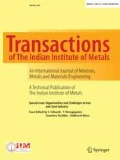Abstract
The present work reports an experimental investigation on influence of microstructures on dry sliding wear performance of different grades of ferritic ductile iron. Ductile cast iron samples of ferritic grade have been subjected to different heat-treatment processes at different temperatures and times. Taguchi optimization technique (L16) has been applied to evaluate the influence of different process variables (load, time, heat treatment, and grade) during ball-on-plate wear test. Meanwhile, analysis of variance (ANOVA) method was adopted to know the significance of aforesaid process variables. ANOVA results confirmed that the heat-treatment process has highest significance (54.76%) within all process variables. Among heat-treated specimens, austempered samples have outstanding wear resistance while the DMS samples have lower wear resistance. In addition, overall utility values have been evaluated by using individual utility values of weight loss and hardness. An obtained overall utility value gives the optimum combination for achieving higher wear resistance and hardness. Additionally, morphology of wear surfaces was examined in scanning electron microscope and the micrographs confirm the existence of inferior surface in terms of abrasive wear, adhesive wear, particle pullout and delaminated sheets on wear track. Enrichment of oxygen element has been observed on the worn path through energy-dispersive X-ray spectroscopy. X-ray diffraction analysis confirms the existence of different compounds like iron and silicon oxides on the wear track surface which may improve its hardness.















Similar content being viewed by others
References
Konečná R, Nicoletto G, Bubenko L, and Fintová S, Eng Fract Mech108 (2013) 251.
Dommarco R C, Sousa M E, and Sikora J A, Wear257 (2004) 1185.
Rashidi A M, and Moshrefi-Torbati M, Mater Lett45 (2000) 203.
Zhou R, Jiang Y, Lu D, Zhou R, and Li Z, Wear250 (2001) 529.
Zimba J, Simbi D J, and Navara E, Cem Concr Compos25 (2003) 643.
Magalha L, and Seabra J, Wear215 (1998) 237.
Dommarco R C, and Salvande J D, Wear254 (2003) 230.
Zhang H, Wu Y, Li Q, and Hong X, Wear406 (2018) 156.
Zhang N, Zhang J, Lu L, Zhang M, Zeng D, and Song Q, Mater Des89 (2016) 815.
Islam M A, Haseeb A S M A, and Kurny A S W, Wear188 (1995) 61.
Sahin Y, and Durak O, Mater Des28 (2007) 1844.
Yang J, and Putatunda S K, Mater Sci Eng A406 (2005) 217.
Mallia J, Grech M, and Smallman R E, Mater Sci Technol14 (1998) 452.
Górny M, and Tyrała E, J Mater Eng Perform22 (2013) 300.
Kumar P, Barua P B, and Gaindhar J L, Qual Reliab Eng Int16 (2000) 475.
Walia R S, Shan H S, and Kumar P, Mater Manuf Process21 (2006) 907.
Omran A M, Abdel-Jaber G T, and Ali M M, Int J Eng Res Appl4 (2014) 90.
Gonzaga R A, and Carrasquilla J F, J Mater Process Technol162 (2005) 293.
Bockus S, and Zaldarys G, Mater Sci Medzg16 (2010) 307.
Putatunda S K, and Gadicherla P K, Mater Sci Eng A268 (1999) 15.
Fordyce E P, and Allen C, Wear135 (1990) 265.
Elsayed A H, Megahed M M, Sadek A A, and Abouelela K M, Mater Des30 (2009) 1866.
Achary J, J Mater Eng Perform9 (2000) 56.
Delia M, Alaalam M, and Grech M, Journal of Materials Engineering and Performance7 (1998) 265.
Erfanian-Naziftoosi H R, Haghdadi N, and Kiani-Rashid A R, J Mater Eng Perform21 (2012) 1785.
Talebi S H, Ghasemi-Nanesa H, Jahazi M, and Melkonyan H, Metals7 (2017) 346.
Dong H Y, Wu K M, Wang X L, Hou T P, and Yan R, Wear402 (2018) 21.
Author information
Authors and Affiliations
Corresponding author
Additional information
Publisher's Note
Springer Nature remains neutral with regard to jurisdictional claims in published maps and institutional affiliations.
Rights and permissions
About this article
Cite this article
Bramaramba, V., Sen, S. Optimization Study on Sliding Wear Characteristics and Heat-Treatment Conditions of Different Grades of Ferritic Ductile Cast Iron. Trans Indian Inst Met 73, 1131–1146 (2020). https://doi.org/10.1007/s12666-020-01947-3
Received:
Accepted:
Published:
Issue Date:
DOI: https://doi.org/10.1007/s12666-020-01947-3




